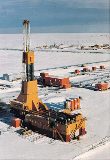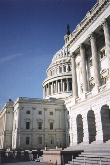United States: Washington in 2001
WASHINGTON IN 2001Energy will get a fresh agendaWilliam Garland, Contributing Editor, Washington Many in the industry and – for the first time in years – many from outside will watch closely to see if the new Bush administration follows through on a more coherent, stimulative policy to deal with U.S. energy shortcomings. Prior to last year’s election and messy aftermath, rising petroleum prices drew more media attention than at any time since the energy crises of the 1970s. In the initial meeting (with Federal Reserve Chairman Alan Greenspan) during his first official trip to Washington as president-elect, Republican George W. Bush signaled that energy would be high on his agenda of issues. After the session with the powerful Fed chairman, Bush said they "spent a lot of time talking about energy. We must be concerned in this country about energy. We must be concerned about shortages and at the same time, obviously, concerned about conservation." His campaign comments, as well as positions on such issues as drilling for more Alaskan oil, already had sparked expectations that Bush is poised to act more aggressively on energy policy than many of his predecessors. This is despite suggestions by some observers that he needs to move cautiously in an area where he, his family and several administration leaders have had close ties. New Commerce Secretary Donald L. Evans, for one, has been chairman and CEO of Tom Brown Inc., an independent oil company where he started as a roughneck in 1975. Vice President Dick Cheney was criticized roundly by liberals during the campaign for his recent tenure as head of Halliburton. Nevertheless, Bush echoed the same theme when he appointed former Sen. Spencer Abraham (Republican-Michigan) to head the Energy Department, noting his campaign pledge of "a comprehensive energy policy for our country." Bush Must Work With Congress Some key congressional officials said they were reluctant to prescribe potential policies before President Bush laid out his 2001 agenda. A spokesman for Sen. Frank H. Murkowski (Republican-Alaska), chairman of the Senate Energy and Natural Resources Committee, said his boss was waiting to take the lead from Bush.
Another committee aide said the panel’s staff in late 2000 gave the chairman "an internal document . . . that sets forth . . . what the committee staff believes would be an agenda for next year." She agreed that Murkowski and other leaders in Congress were unlikely to move publicly without some coordination with Bush. Moreover, she said, the President probably would consult Murkowski and other key lawmakers before making any moves. "The only thing he has really said publicly . . . is that he will be doing a comprehensive energy package very early on, because he believes there has been no energy policy in the last eight years and that this nation needs a balanced energy policy . . . that will make use of all our sources of power and that will achieve balance between exploration and development, and renewables, alternative fuels and conservation." She said that a Bush campaign document on energy policy included several proposals backed by Murkowski, including development of a small portion of Alaska’s Arctic National Wildlife Refuge (ANWR); more opening of other public lands and offshore areas for upstream projects; and funding to advance clean coal technologies. There was little doubt that Murkowski and others expect a significant showdown this year over allowing drilling in ANWR, considered for years to be one of the richest remaining U.S. zones for oil and gas. With the Clinton administration firmly against ANWR exploration, any movement by Congress in the last eight years would have been virtually useless, faced with immediate presidential veto. Indeed, former President Clinton vetoed one measure passed by Congress in 1995 that would have gotten the ball rolling. Bush and former Vice President Gore squared off over the issue several times during the campaign – Bush was up front in his desire to see drilling go forward. He argued that it could be done with little, long-term environmental damage, yet add more to the nation’s declining resource base than any other single policy. Murkowski’s aide on the Senate panel pointed out, however, that even with Bush’s support, the issue would be tough. "There is more agreement in the Bush camp than . . . in the Clinton administration, but we have to face reality that we have a 50 – 50 Senate. So while things might have eased on the one hand, they might have tightened on the other." She said she "wouldn’t predict either way" in Congress. "A lot depends on what’s happening with our energy situation. Are things suddenly going to improve? Are they going to get worse?" There also was the chance as this article was prepared that Clinton, prior to his departure, potentially could up the ante b further designating ANWR as a national monument, though the impact of such an action and whether it really would derail initiatives by Bush or Congress remained unclear.
In a December essay in The Washington Post, Murkowski skillfully outlined his arguments in favor of opening ANWR, likely to be used by Bush officials and other proponents in the congressional debate that lies ahead. Almost all of Murkowski’s arguments were aimed at environmental concerns that are at the heart of ANWR opposition. Most importantly, Murkowski drew a clear distinction between the 17.5 million acres in the refuge that form an off-limits enclave the size of South Carolina and a 1.5 million-acre section along the coastal plain, originally designated by Congress as a potential area for resource development. He said the larger enclave "can never be developed, nor should it be." But the coastal plain is "distinct from the rest of the ANWR . . . a flat, treeless, almost featureless plain . . . that extends from the Brooks Range northward to the Beaufort Sea. There are times on the coastal plain when exposing human flesh to the elements would ensure death." Home to one village of 260 Intupiat natives and (in the winter) to five species of birds, polar bears and lemmings, only a 2000-acre coastal strip of ANWR would be open to operations, and then only during the harshest months of winter, said Murkowski. They would use "ice airstrips, ice roads and ice platforms . . . when no caribou are present. If the well is dry, it is capped. When the ice melts in late spring, there is little remaining evidence of the work and minimal impact on the land." He said exploration is strongly favored by the Intupiats, Alaskans and – by a 54%-to-36% margin in a Christian Science Monitor poll – most Americans. Citing estimates of 16 billion bbl of potential production, Murkowski said, "It would substitute for what we would otherwise have to import from Saudi Arabia for the next 30 years. Will development of the coastal plain make us independent of foreign oil? No, but it can make us less dependent." IPAA’S Ideas An IPAA spokesman said the trade group crafted an energy policy agenda late last year that its leaders hoped would carry some weight, both in the new administration and on Capitol Hill. IPAA’s policy agenda pointed out that the U.S. cannot stick its head in the sand. "Like it or not, the nation will be dependent on fossil fuels for the foreseeable future . . . Petroleum and natural gas currently account for approximately 65% of the nation’s energy supply . . . Natural gas demand, for example, is expected to increase by more than 30% over the next decade." To start, policymakers need to be aware of growing differences in markets and needs for gas and oil, said IPAA. "Future energy policy should rely on market forces to the greatest degree possible. For natural gas, the market is strong and active . . . In the U.S., drilling rig counts for natural gas are running at rates that are as high as they have ever been since (such) drilling was distinguished from petroleum. The principal constraints are finding the capital to invest, getting access to the resource base, finding competent personnel and obtaining rigs. "Oil, however, is a different situation," said the trade group. "Although the U.S. remains the second or third largest producer of petroleum, it is operating from a mature resource base that makes the cost of production higher than in competitor nations. More importantly, most other significant petroleum-producing countries rely on their petroleum sales for their national incomes. Thus, the market price for petroleum will be largely framed by production decisions driven not by the market, but by the politics of these countries. U.S. domestic policy decisions must reflect this reality, looking to this factor in taking actions that can affect domestic production and producers." For one thing, said IPAA, the country needs to react when international decisions crater the oil price, as they did in 1998 and early 1999. Little was done in the last crash and "the nation lost about 10% of its domestic oil production – most of which has been made up by imports from Iraq." In general, U.S. policy needs to recognize that steep investment costs for oil and gas operations tend to derive from internal cash flows, because the industry "must compete for capital against more lucrative investment choices . . . The federal tax code is a key factor in defining how much capital will be retained." IPAA also stated that "enthusiasm needs to be rekindled for the administration and Congress . . . to enact provisions designed to encourage new production, maintain existing production and put a ‘safety net’ under the most vulnerable domestic production – marginal wells." Among IPAA’s "mix of tax reforms that have widespread support" are provisions to:
The first of these, in particular, has been shuffled around Washington and Congress during the last several years, finding its way most recently into legislation by Sen. Kay Bailey Hutchison (Republican-Texas) and a group of House members that received at least lip service from Clinton officials. Former Energy Secretary Bill Richardson advocated the measure directly with the Treasury Department, citing a DOE analysis that it could stem the loss of 140,000 bpd of U.S. oil output during times of low prices. The credit would phase in, when oil prices are between $14 and $17/bbl, and when gas prices are between $1.56 and $1.89/Mcf. Oil wells that produce less than 15 bpd would receive a $3/bbl tax credit for the first 3 bpd. Gas wells would get a break of 50 cents/Mcf for the first 18 Mcf of daily output from a marginal property. In other areas, IPAA officials have said opening access to public lands would climb up the agenda. The policy guideline noted, in particular, that world-class deposits of natural gas still are off-limits under U.S. lands, both onshore and offshore. As with the ANWR debate, IPAA said it would stress the capability to develop the resource base "in an environmentally sound and sensitive manner," especially with newer technologies. Federal royalty issues, again both onshore and offshore, also will influence the level of development even in areas where access is granted, said IPAA. Access To More Resources But the industry’s call for more room to operate offshore may run into early obstacles, according to some indications. Sen. John Breaux (Democrat-Louisiana) said after a meeting with Bush last December that the new administration might have reservations about going too far. He told The New York Times that Bush promised not to allow new drilling off the coasts of states that object, potentially including California and Florida for at least portions of their offshore areas. But Breaux added, "The impression I have from talking to Mr. Bush is that he feels we do not have a national energy policy that is focused on developing our domestic resources. He wants to move in a lot of areas." An unidentified Bush aide was quoted as saying that "stimulating natural gas production is probably the number one thing" on the new president’s energy agenda. Access also is the theme coming for 2001 from the National Ocean Industries Association. In a statement for World Oil, the trade group highlighted the need to reach offshore gas reserves that could have helped with the spike in wellhead prices last year, representing shortfalls in supply. "This time of change presents us with the opportunity to breathe new life into our nation’s energy policy," said NOIA. "The Department of Energy’s advisory National Petroleum Council has released a comprehensive report that shows an enormous surge in natural gas demand over the next decade – a growth of at least 30%. We are currently unprepared to meet this demand, and we need to think hard about policies that will not jeopardize our energy future. We must ensure that our offshore industry is able to access this resource base . . ." API Retains Its Stance API President Red Cavaney pointed out last year that it had been a quarter- century since a broad debate over U.S. energy policies had occurred. "Our nation has fallen short of addressing our energy challenges in a sustainable, strategic fashion . . . We have a very, very different world today" from that addressed by the last far-reaching energy review. An API spokesman said Cavaney’s recommendations (in last year’s call for a national energy debate) still stood as API’s latest advice for Bush officials and Congress. Cavaney said a new energy policy from the view of major U.S. oil companies, at a minimum, should include:
A spokesman for the Natural Gas Supply Association (NGSA) in Washington, primarily representing major and independent U.S. producers, said his trade group also hoped to participate in setting the energy policy agenda. Key areas for the producers’ group will include encouraging greater industry access to U.S. lands, and promotion of "increased regulatory scrutiny of pipeline rates." The group plans to work with lawmakers to "prevent interference with a highly competitive market." NGSA this year also hopes to mount an extensive campaign for greater public awareness of natural gas market conditions.
Other Factors One policy area may be more important than specific provisions recommended by Bush or passed by Congress. Each administration takes its own approach to dealing with the world’s largest producers, in and outside OPEC, which ultimately sways world pricing. The Reagan administration worked covertly with Saudi Arabia in the mid-1980s, according to former officials, to bring down oil prices and interrupt cash flow to the country’s primary Cold War opponent, the Soviet Union. There was nothing covert, of course, about the Persian Gulf War in the first Bush administration, the nation’s most aggressive intervention into Middle Eastern and, most would agree, oil affairs. Clinton officials negotiated openly with producers – especially in the Middle East – to boost production and moderate spiking prices in 2000. Bush said in the campaign and as president-elect that he would, to some extent, follow the Clinton model and deal directly with OPEC to influence production levels at times of higher prices. At the ceremony for Abraham’s DOE appointment, Bush stated bluntly that "a cornerstone of our diplomatic efforts will be to work with our friends in the Middle East, particularly as it relates to matters of energy." As IPAA pointed out in its energy policy guidelines for the new administration and Congress, finding the right approach when jumping into market-oriented discussions can be tricky, even when the market is largely undergirded by policies of a cartel. "The popular call for OPEC to ‘open the spigots’ fails to recognize that the low oil prices of 1998 – 1999 ripped capital from the upstream industry around the world," said IPAA. "Today, only Saudi Arabia has any significant excess production capacity, and no one knows just how much or whether the oil is of a quality that can be refined in most refineries. The collateral damage of low oil prices on the natural gas industry is affecting gas supply today, and will until the industry recovers" from the loss of infrastructure and some 65,000 jobs at the end of the 1990s. In another area related to pricing, Bush may prove less objectionable than the past administration from the industry’s view. At the urging of former Energy Secretary Richardson and former Vice President Gore, Clinton agreed last year to tap the Strategic Petroleum Reserve. It was what many analysts regarded as an obvious attempt to target higher prices, although the administration argued it would bolster flagging supplies of heating oil for the Northeast. Had Gore won, dipping into the SPR might have become
routine as a means of setting a cap on upward pricing movements. Bush loudly protested the action on the
campaign trail, insisting that it amounted to direct and dangerous, short-term market intervention. As
president, he will be much more likely to keep strict reins on the SPR and stick to its intended purpose for
use during severe supply disruptions.
|
|||||||||||||||||||
- Applying ultra-deep LWD resistivity technology successfully in a SAGD operation (May 2019)
- Adoption of wireless intelligent completions advances (May 2019)
- Majors double down as takeaway crunch eases (April 2019)
- What’s new in well logging and formation evaluation (April 2019)
- Qualification of a 20,000-psi subsea BOP: A collaborative approach (February 2019)
- ConocoPhillips’ Greg Leveille sees rapid trajectory of technical advancement continuing (February 2019)






